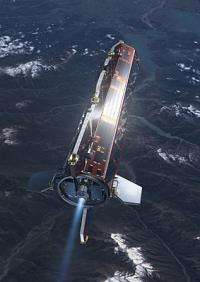GOCE successfully completes early orbit phase

ESA's GOCE satellite was formally declared ready for work at 01:00 CET on 20 March. During the critical Launch and Early Orbit Phase beginning with separation from its booster on 17 March, GOCE was checked out to confirm that all of its control systems are operating normally.
The end of the Launch and Early Orbit Phase (LEOP) came overnight after GOCE was switched to Fine Pointing Mode. This means that all of its systems are working normally and the satellite is ready for full commissioning of its scientific instruments. With the end of LEOP, normal communications between the satellite and the ground are now being provided by ESA's ESTRACK station at Kiruna, Sweden.
"Everything is working well and we have a healthy satellite. Today, we will end round-the-clock staffing in the Main Control Room and move the Flight Control Team to regular work-day operations in the Dedicated Control Room," said Flight Operations Director Pier Paolo Emanuelli speaking this morning at ESA's European Space Operations Centre (ESOC), Darmstadt, Germany.
Satellite-to-satellite tracking in operation
A major aim of this week's LEOP work was to bring the Satellite-to-Satellite Tracking Instrument (SSTI) - a highly accurate GPS (Global Positioning Satellite) receiver - into full operation. Emanuelli confirmed that it is working normally.
"Switching on the SSTI was especially important, as this meant the satellite could start performing its own autonomous orbit determinations. SSTI identifies GOCE's position very accurately, and we need this functioning before we can bring the satellite into its final drag-free operations mode," he said.
First science data sets already received
In addition to providing realtime navigation data for flight control, SSTI is one of GOCE's two payload instruments and it is a very accurate scientific tool for recording and reconstructing the satellite's actual orbit. The first SSTI data have already been successfully received at the Payload Data Ground Segment at ESA's Earth Observation Centre (ESRIN), Frascati, Italy.
"Receiving initial science data from SSTI so soon has been an excellent first step and, now that the SSTI is operating, we are already proceeding with commissioning of the scientific payload," said GOCE Mission Manager Rune Floberghagen, who worked in ESOC's Main Control Room alongside the Mission Control Team during LEOP to monitor progress.
"GOCE is operating very well, and we are already looking forward to commissioning our other main instrument, the Electrostatic Gravity Gradiometer, starting in mid-April. It's going to be a very busy but tremendously exciting time as we begin science operations," said Floberghagen.
In the coming weeks, the mission is expected to achieve a number of crucial milestones, including switching on the electric ion propulsion, switching into Drag-Free Attitude Control mode and lowering the orbit to the planned altitude of about 260 km.
Source: European Space Agency




















